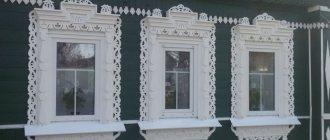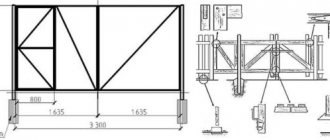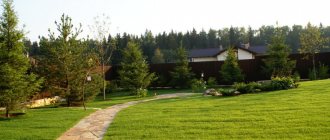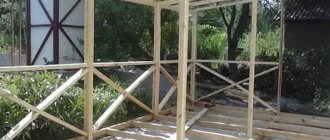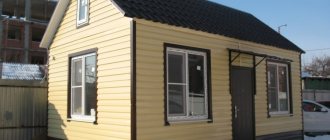Platbands are strips for masking seams located at the junction of the window frame and the wall. The corresponding element is also intended to complete the glazing design on the outside.
The dual purpose of platbands complicates their selection and installation. Therefore, thematic products deserve a separate topic.
Why do we need platbands?
Platbands are part of the finishing of the external window opening, which are overlay strips made from a variety of materials.
They provide not only design, but also have additional auxiliary functionality:- close the gaps between the joints of the working surface of the window being installed;
- protect the polyurethane foam layer from ultraviolet rays;
- prevent the penetration of rainwater and moisture;
- protect from weathering.
Design samples can be seen in the photo of window trims.
Installation features
The finished casing is mounted to the window opening in the following ways:
installation on a blind tenon. Such parts are installed on the inside. Special holes are created in the frame for them. Glue is applied to the tenon and it is inserted into the groove. Such fasteners protect the platbands from dust and moisture;
Installation of complex multi-component elements will require some skill
a through tenon is used. In this case, the joint must be carefully treated with varnish. Similar techniques are used if the window is wooden. For installation on metal-plastic, special liquid glue is used.
Installation sequence
When installing plastic windows, the gaps formed between the wall and the frame are filled with special seals to ensure the sealing of the structure.
After filling the inter-alkaline space, all excess is cut off, and then the junction of the glass unit with the wall is puttied and the slopes are installed.
At the end of the work, the platbands are attached, which visually hide all the gaps processed outside and inside.
In addition to panels for the external decoration of external platbands, similar materials for interior decoration are offered on the market. Such materials do not seal gaps, but serve only external design functions.
Basic Rules. What not to do
Below is a list of rules that will help you avoid the most common problems.
- It is recommended to use a board 3-4 cm thick as the starting material.
- Don't jump into complex patterns right away. First, it is better to practice on ordinary round parts that are easy to make with a drill.
- The width of the workpiece should be such that it is enough to cover the ends of the walls and protect it from moisture.
- Carved elements should be placed along the grain of the wood - this will prevent cracking.
When choosing a stencil, it is better to pay attention to patterns with large elements, since small ones will look crumpled, as a result of which the finish will not have the desired decorative effect.
Important! Before starting work, you should calculate the future costs of time and money, as well as the feasibility of the idea itself. In the absence of high skills in working with wood and interest in the process itself, it is easier to buy ready-made platbands.
Moreover, it is advisable to first familiarize yourself with photographs of different products. This way you can find a suitable option or get inspiration for creating something yourself.
Platbands with flat shape
Plastic platbands have a predominantly flat plank shape. This form is the most common because:
- it is convenient to work with during installation;
- has an affordable price;
- gives the window structure a neat appearance;
- has proven to be easy to maintain.
Flat strips can also be made of aluminum, wood and polyurethane.
Telescopic
This is a modern type that has been used quite often lately. You will not need additional materials in the form of screws or the same nails. Such platbands are placed just in the cracks. This ensures a secure fit as a whole.
Priority should still be given to the second type. But to install it you need to remove the windows. Doing this is not always convenient, if not even impossible, so they often resort to the first option. But, we have to admit, the telescopic casing is much more convenient to use.
Figured window decoration
Carved window frames are an exclusive material and, as a rule, are created according to an individual decision.
Such exclusive framing can be made of wood or plastic, and plastic material is more difficult to find on sale than wood.
Since this is an individual solution for windows, the cost of such platbands will differ significantly from flat frames.
The nuances of creating templates on your own
To prepare the platband, you need to develop a design and implement it using a stencil. The latter allows you to transfer the picture to wood.
Not every person has drawing skills. You can simply find and print the pattern you like, the main thing is to maintain a consistent style. Patterns of strict geometry and vegetation should not be combined.
Subtleties of creating a template:
- Harmony of the color palette of external walls and decorative elements.
- Selection of the optimal size.
- Choosing the best type of coating.
- Details are written along the direction of the wood grain.
Shaped forms
The shaped type is a framing strip that has a semicircular shape. Such shaped profiles have reliefs of strips of varying depths and widths.
The production of shaped platbands is made from plastic or polyurethane. There may be profiles made of wood material on the market.
How to choose the right wood?
Wooden frames are popular. At the same time, the performance of the product depends on the type of wood chosen.
The following options are worth considering:
- Ash, beech and oak are hardwood varieties. They are durable, but difficult to cut patterns on;
- It is much easier to process soft hardwoods - linden, aspen and alder. You can even carve patterns on their surface by hand. Such surfaces must be carefully treated with special compounds;
- It is recommended to create small elements from cherry and apple trees that can be attached to the base;
- Pine and birch are characterized by ease of processing and good performance properties.
Helpful information! Different combinations of wood types can be used. In this case, special protective impregnations should be used.
The nuances of choosing the right wood
To create truly durable and beautiful structures, it is important to pay careful attention to the choice of wood and its varieties:
- hard (oak, beech, ash): they are durable, but making cuts on them is not very easy;
- soft (alder, linden, aspen): perfectly amenable to processing, but require pre-treatment with special compounds;
- apple and cherry branches: perfectly convey the smallest patterns, attached by attaching to the base;
- birch, pine: easy to process;
- combinations of different species: require mandatory processing, allow you to create an original window frame.
Platband made of plastic raw materials
Window plastic is the most budget option, giving an excellent aesthetic appearance to the building. The only negative factor of this material is the short service life of the product compared to wood and polyurethane materials.
The color range of plastic profiles is quite extensive. Manufacturers, as a rule, make them to match the color of the profile of window structures.
Gallery of patterns
We invite you to admire the variety of wooden patterns and decorations on the houses.
Platbands and cornices
Other façade elements
In addition to carved platbands, other architectural elements of the facade can be made in a carved version. What they are called and what they can look like is shown in the table:
| Element name and appearance | A comment |
Towel and hairstyles | A prichelina is a carved board mounted along the roof slope. The towel is located either at the ends of the rails or at their intersection. |
Skate | The ridge crowns the roof at its highest point. |
Sandrik | Another option for window decoration is a small decorative cornice called sandrik. It can also be installed above the door, including indoors. Often has a triangular or spherical shape. |
End board | This element is used to decorate the protruding ends of logs. |
| Valance | A valance is a decorative board placed horizontally under the eaves of a gable or porch. |
Modillions | Modillions are overhead elements mounted under the cornice, which in appearance resemble small brackets. |
Panels | Panels are overlay elements in the form of patterned tiles of square or rectangular shape. Most often they are installed in the window sill area. |
Half-timbered buildings | Those who are close to the old European half-timbered style will be interested in imitation using wood. Basically, there are geometrically correct designs made from straight slats, but shaped elements can also be used. You can learn about wood carving styles from the article on our website. |
25 photos of carved facade elements
3
6
Stencils for download
We offer several stencils that you can use to cut patterns. It is enough to download them, print them on a wide-format printer and transfer them to the board, making up a whole ornament from individual elements:
Polyurethane finish
Polyurethane framing, along with plastic, is very popular and is often used in the finishing of buildings.
The advantage of polyurethane is its durability and practicality. Due to its light weight, such a platband is easy to install, adjust to dimensions and assemble.
The profile surface has a multi-relief pattern and can be painted during operation.
Finishing
Carving wood beautifully is not everything.
Attention! It is important to finish the products so that they not only look impressive, but can also maintain an attractive appearance for a long time.
To protect wood from ultraviolet radiation and atmospheric moisture, it can be coated with oil, wax, colored varnish or paint. It is better to give preference to the first two options, since the carved product processed by them looks the most advantageous and noble.
Wood protection oil
Before applying the protective coating, the wood is sanded until smooth and tinted with stain - it applies much more evenly if applied with a spray. Well, varnish or wax will give the carving a final soft shine.
You can make your own wax mastic by mixing 1 part beeswax with two parts turpentine and heating it all in a water bath. Decor treated in this way will look gorgeous and last a long time.
Wooden types
Platbands made from natural wood pieces will decorate windows for many years, provided that the material is treated with high-quality protective agents.
The cost is an order of magnitude higher than that made from polymer materials. The disadvantage of this material is its susceptibility to fading and the need for additional painting.
Purpose of framing
The purpose of window casings, first of all, includes framing the facade of the building, creating its unique style, a kind of “face”.
In addition, they protect the space between the frame and the window opening, preventing dust, dirt, precipitation, and sounds from the street from entering the house.
Previously, platbands were considered a kind of protection, a talisman for the home against the penetration of evil spirits.
This was evident even from the patterns that depicted plants and mysterious figures, which necessarily carried a special meaning.
Today, such a design, provided that it was chosen correctly, can modify the geometry of the structure: expand or extend.
The meaning of carved elements
When planning to decorate window openings with such structures, it is important to first study their meaning:
- the sun and kokoshnik are symbols of energy and life;
- the snake personifies wisdom, fertility;
- the cross represents the harmony of the spiritual and material worlds;
- vegetation gives a feeling of unity with nature;
- earrings are a sign of the hospitality of the owners of the house;
- the silhouette of a bird is a traditional connecting element.
Owners of wooden houses should spend a little time and add elegance to their home. This is not only beautiful and stylish, but also good protection for the home from adverse factors.
One plane of windows with a wall
First, slopes are installed to cover gap areas and unsightly areas. A profiled sheet is attached to the frame structure and a slope panel is inserted into it.
The edges of the platbands are cut with an angular cut of 45 degrees. This cut will help make it easier to join the corners.
Invoices
This option is older, but should not be neglected now. The method of installing it is quite simple: it is done on top of the frame.
Little effort is required, but this type of platband helps enough: it prevents both sunlight and precipitation from penetrating. The joints are reliably protected thanks to this.
Different plane of windows with wall
If the trim panels are attached separately from the wall surface, then it is necessary to carry out a preliminary fitting where the slopes will be attached with a mark being established. Next, liquid nails are applied to the back side and glued along the marked line. Corner joints are also taped.
Wooden frames for windows in a wooden house are mounted using dowels or self-tapping screws, the locations of which are marked in advance. The connecting hole is sealed with epoxy resin, which is pre-mixed with sawdust.
Selection of drawing
With all the abundance of options, wooden platbands can be divided into three large groups:
- slotted;
- with an applied pattern;
- carved.
The peculiarity of slotted platbands is that the pattern is formed by through cuts in the board. In overlays, the pattern is cut out separately and attached to the platband using glue or nails.
The last type is the most complex, but it also looks more impressive, since the relief is cut directly onto the surface of the part.
Whatever option is chosen before starting work, it is worth making a simple drawing of the future product. You can sketch a drawing on it, this will allow you to evaluate the attractiveness of the platband and avoid mistakes during its manufacture.
The choice of drawing directly depends on the wishes of the master and his qualifications. A beginning carver should choose a simple geometric or floral design. It is better if it contains only large elements.
You can make a sketch yourself or choose a ready-made one and print it.
To transfer the image onto the tree, just cut out the outlines with scissors, resulting in a practical template, or use carbon paper.
Self-production
You can make window treatments yourself. In this case, window trim stencils are used. Using a stencil, the shapes of the design are applied, after which they are cut out.
It is advisable to treat the material with water-repellent agents and antiseptics. You can treat the wood with stain and coat it with moisture-resistant varnish.
Video description
The following video will show you how to prepare the mounting surface for platbands on chopped facades:
Since this window frame does not carry any load, each strip can be attached at only 2-3 points. The fastening itself is carried out using finishing nails without a head or dowels. The first option is simple and quick, but upon close inspection the nails are visible on the surface. Fastening to dowels is invisible, especially if you use blind holes rather than through ones.
The technology for mounting on dowels consists of drilling holes in the platband and casing exactly opposite each other, for which precise markings are made. Their total total depth should be equal to the length of the wooden dowel, and the diameters should also match. Before installation, the dowel is coated with glue, inserted into the hole in the casing, and a casing is attached to its free end.
A dowel or dowel is a wooden cylinder for hidden connection of parts Source zipbolt.ru/storage
If the hole in the platband is through, after the glue has dried, it is puttied and sanded. With a deaf person there is no need for this, since the dowel remains invisible.
Dimensions of finishing panels
It is very important to make an accurate calculation of the material, since even a small deviation can cause gaps and inconsistencies.
The size of the frame largely depends on the corner connection, so before work you need to carefully measure and count everything.
Folklore image of Baba Yaga
Everyone read Russian folk tales in childhood, and it is from them that Baba Yaga is known to us. Therefore, if you decide to start drawing this old woman, you should turn to children's books to understand what this character is. So, let's characterize Baba Yaga: she lives in her home - this is a hut on chicken legs. She can use witchcraft and, in addition, she can fly in a mortar, covering her tracks with a broom. If we talk about the character of Baba Yaga, she is not always a harmful and evil old woman; in some fairy tales she admonishes the hero and gives him magical objects, for example, a guiding ball of thread or a magic horse. Not only poets and writers, but also artists such as Malyutin, Viktor Vasnetsov and others have repeatedly turned to the image of Baba Yaga.
Manufacturing technology
The design is transferred onto the workpiece using a stencil, after which it is formed by sawing out. In this work you can use a jigsaw or a router.
The operating algorithm is as follows: using a drill, a vertical hole is drilled in a closed place, into which a jigsaw or router is inserted. The tool carefully and slowly cuts out the required sizes and shapes.
After sawing, the pattern is processed twice with sanding paper with a medium-grained and fine-grained surface. At the final stage, the working surface is treated with a waterproof sealant.
Video description
An interesting way of making carved parts using wood crowns is shown in the video:
- It is easier to make an overlay decor by cutting out various geometric shapes, curls or flowers from wood along the outer contour and fixing them on the surface of a flat plank. The result is a three-dimensional pattern, the convexity of which can be emphasized by painting the substrate and decorative overlays in different colors.
Note! When renewing the paint coating, it will be more difficult to accurately apply contrasting paint than at the installation stage, when all the parts can first be processed and then connected.
Photos of window trims
Total
Category: Construction
Furniture filling for the living room
Before purchasing furniture for the living room, you should determine for what purpose it is needed:
- For placing and storing things.
- For receiving guests.
The standard option for the living room interior is the presence of:
- Wardrobe.
- Armchairs.
- Sofa or sofa.
- Coffee table.
- Showcases.
- Dining table (if space allows).
The most important attribute of the living room is a place to relax - a sofa. Many people are concerned with the question: “How to choose a sofa for the living room so that it is beautiful, comfortable and functional.”
First of all, you need to decide on the size of this piece of furniture, because if the area of the room is limited, a large product will not be appropriate
When choosing a sofa you should pay attention to several details:
- Shape (straight, angular, U-shaped).
- Degree of hardness (soft, medium hard, hard).
- Quality frame and upholstery.
- Manufacturing materials.
- Execution style.
For small-sized apartments, designers advise choosing a classic or corner shape of a sofa, since this way you can significantly save space. You need to choose the degree of rigidity yourself, as you like.
Natural materials are preferable because they are more durable and safer for health. The execution style is selected in accordance with the main style of the living room.
Average prices in the Russian Federation
Considering that products for framing window openings in wooden houses are supplied to the market by hundreds of manufacturing enterprises, each of them guarantees consistent quality, and competition equalizes average prices :
- Direct, wooden cashing from pine - from 500 rubles. for 1 p.m.
- Direct, wooden cashing from larch - from 850 rubles. for 1 p.m.
- Direct, wooden cashing made of oak - from 900 rubles. for 1 p.m.
- Profiled wood products – from 700 rubles. for 1 p.m.
- Carved wooden cash - from 1000 rubles. for 1 p.m.
- PVC elements for framing - from 450 rubles. for 1 p.m.
- Cash-in steel parts, painted in RAL - from 900 rubles. for 1 p.m.
The above prices may vary slightly depending on the volume of the order, the complexity of the design, the remoteness of the facility and the internal policy of the production company.
